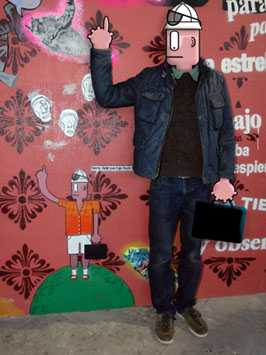The following is an excerpt from my forthcoming article “From Graffiti to Street Art: How Urban Artists are Democratizing Spanish City Centers and Streets.” Transitions: Journal of Franco-Iberian Studies 8 (2012): 9-34.
The acting out of unrestricted engagement with the city on the part of street artists is contagious, and therein lies its strength. The perception of the city as continually open to alteration has the potential to spread from urban artists to the greater population, and to reactivate and democratize Spanish public space. This type of innovative urban intervention requires a new body that is not solely a physical body, but one that is at the same time a network of constantly recombining links between the material world and the virtual world of ideas. The defining characteristic of the new body of the street artist is its register of co-existence between the street, self, and art.
The new body that street artists are modeling is one that I call the emergent urban body—emergent, because it is constantly in a process of being created again and again, and urban, because it lives in the city. Dr. Case’s 2012 project Symbiosis – Artists with Character best exemplifies the metamorphic quality of the emergent urban body. In this experiment, Dr. Case took pictures of graffiti writers and street artists, digitally removed their faces from the photographs, and replaced them with the countenances of one of their creations, thus merging the physical bodies of the artists with the imaginative, symbolic faces of their fictional characters.
In so doing, as the etymology of the title of his project, symbiosis, suggests, the material and the symbolic “live together” in the emergent urban body. The original impetus for the project was Dr. Case’s obsession with documenting urban art on the Internet. Part of the documentation that he was compiling was photographs of graffiti writers and street artists caught in the act. Because these acts are illegal and can carry fines of up to 3,000 euros in Spain, urban artists wanted Dr. Case to find a way to hide their faces. Instead of using large pixels to disguise identity, a technique employed in police photos and videos, Dr. Case decided to fuse art and artist. The metamorphosed heads of the street artists in Dr. Case’s Symbiosis are the pictorial equivalent of street art monikers, the false names that street artists give themselves. Both the pseudonyms and the mutated heads hide the identities of street artists while at the same time revealing certain heightened marks of identity. The blurring of the boundary between artist and art in Dr. Case’s project mimics the street artists’ continually evolving relationship with their exterior world. Subjectivity for the emergent urban body is a process of perpetual interaction with people, places, things and ideas. On the continuum going from street artist to world, there are different points, two of which are the street artists’ assumed name and character. At any given moment, the flows and connections along the continuum can be reassembled in new ways.
Dr. Case explains the project in his own words in the following video (with English subtitles):




